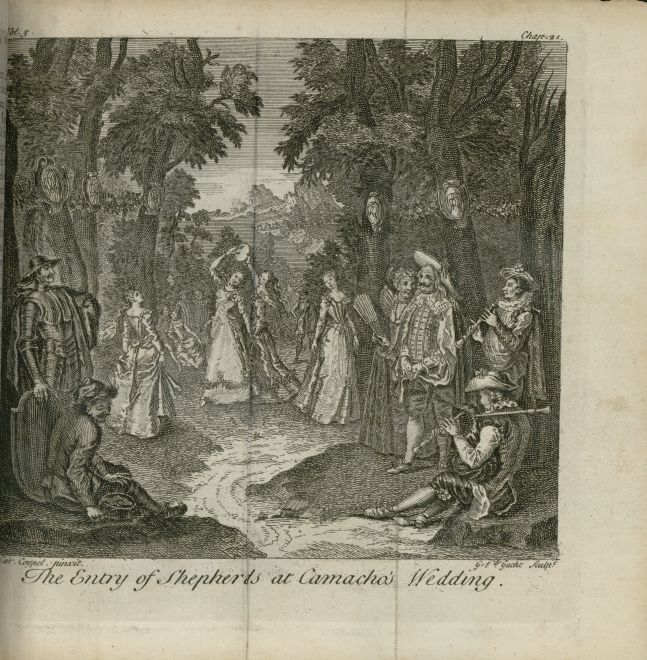
click to enlarge
Don Quixote observes a dance of shepherdesses in Camacho's wedding. "También le pareció bien otra que entró de doncellas hermosísimas [...]. Guiábalas un venerable viejo y una anciana matrona [...]. Hacíales el són una gaita zamorana" (20:2).
Court scene; the stylized dancing shepherdesses and the bagpipes player are very remarkable.
Good drawing and engraving.
2 - In 1731 edition, volume III is in tome II; in 1725, there were four tomes.
3 - Placed in chapter 21:2 according to its own reference, but this indication is wrong. This illustration should be in chapter 20:2, previous to "The Entry of Love and Wealth at Camacho's Wedding".
4 - "Esto que parece una pastoral de gran tono, una bergerie cortesana, con empelucada música de Rameau, en un bosquecillo artificioso, pintado por Watteau o Fragonard, no es tal cosa. Esto -¡quién iba a decirlo!- son las Bodas de Camacho. Mirad las pastoras ingenuas, en sus sencillas y rústicas danzas; mirad el traje, el porte y el monumental sombrero de ese pastor de raso y seda, que está a mano izquierda [right in our engraving]; mirad las hombreras, el peinado, el escote y el colosal abanico de esa bondadosa pastora que le acompaña; mirad los almibarados músicos, con su rabel y su zampoña. ¡Ah! Y no dejéis de contemplar, sobre todo, a ese tímido, joven y esbelto Sancho Panza, que parece como ruborizado, a mano derecha [our left], ni al Don Quijote garboso y gallardo, que se yergue a su lado, como un guerrero de guerras galantes, apoyado en el escudo, el brazo diestro arqueado airosamente y cubierto con un manto rozagante, mientras le brota del yelmo una finísima y elegantísima pluma, que parece el chorro aéreo de un surtidor versallesco" (Givanel 117-118).